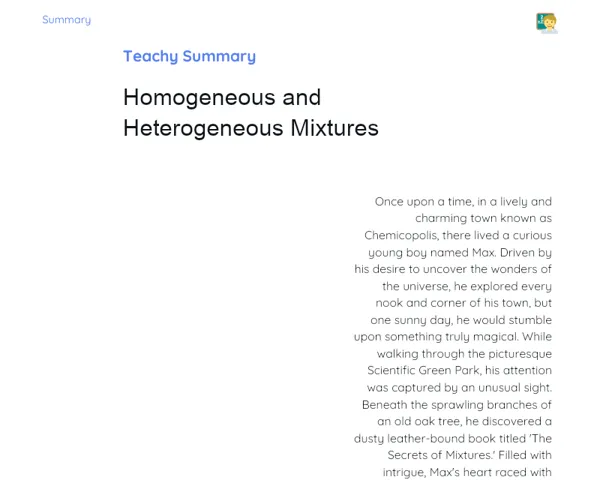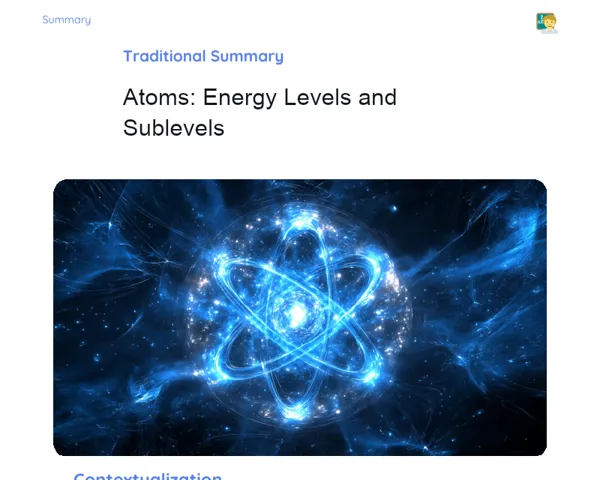Socioemotional Summary Conclusion
Goals
1. Understand the concept of mole and its significance in chemistry.
2. Learn to compute the amount of substance in moles and relate it to the quantity of atoms, ions, or molecules.
Contextualization
Have you ever wondered how many atoms are there in a tiny grain of salt? 🧂 The answer may astound you! By using the concept of the mole, we can quantify these minuscule particles, making the unseen become visible! Let's embark on this exciting journey and uncover the fascinating world of massive numbers in chemistry! 🌟🔍
Exercising Your Knowledge
Mole
The mole is a fundamental unit in the International System of Units (SI) that measures the amount of substance. One mole is defined as the amount of any substance that contains the same number of elementary entities (atoms, molecules, ions, etc.) as there are in 12 grams of carbon-12. This remarkable figure is known as Avogadro's Number, and its scale helps us comprehend the microscopic nature of chemical reactions!
-
Definition: A mole is the amount of substance that contains exactly 6.022 x 10²³ elementary entities.
-
Chemical Context: In chemistry, the mole is used to quantify substances and ease stoichiometric calculations.
-
Visualization: Think of a mole like a 'magic box' holding 6.022 x 10²³ particles, whether they are atoms, molecules, or ions.
Avogadro's Number
Avogadro's Number (6.022 x 10²³) signifies the count of particles in one mole of any substance. This number is a crucial constant in chemistry and aids us in converting between the atomic/molecular scale and the visible macroscopic scale.
-
Universal Constant: Avogadro's Number is a constant that allows us to explain and perform calculations with macroscopic quantities of substances.
-
Conversions: We utilize Avogadro's Number to convert between moles and the number of particles.
-
Importance: This number enables us to work with quantities we can see and measure, like grams and liters, based on extremely small amounts, such as atoms and molecules.
Molar Mass
Molar mass is the mass of one mole of a substance, expressed in grams per mole (g/mol). It is vital for connecting the mass of the substance (which we can measure) to the number of moles (giving us insight into how many particles are there).
-
Definition: Molar mass is the mass of one mole of a substance, expressed in g/mol.
-
Calculation: It can be determined by summing the atomic masses of the elements constituting the substance.
-
Application: We use molar mass to convert between the mass of a substance and the amount of substance in moles.
Key Terms
-
Mole: The unit that measures the amount of substance in the International System of Units (SI), equivalent to 6.022 x 10²³ elementary entities.
-
Avogadro's Number: The constant that represents the number of particles in one mole, approximately 6.022 x 10²³.
-
Molar Mass: The mass of one mole of a substance, expressed in grams per mole (g/mol).
For Reflection
-
How can grasping the concept of the mole assist you in tackling practical challenges in daily life, such as medication dosages or mixing ingredients for a dish?
-
Describe a situation where you encountered emotional hurdles while solving math or scientific problems. How did you cope with those feelings, and what could you do differently next time?
-
In what ways can learning to calculate moles and understanding molar mass bolster your critical thinking and problem-solving abilities?
Important Conclusions
-
The mole is a vital unit in chemistry that facilitates precise measurement of substances at both atomic and molecular levels.
-
Avogadro's Number helps us comprehend the number of particles in a mole and serves as a foundational constant.
-
Molar mass links the mass of substances with the amount of moles, making calculations and real-world applications easier.
-
Learning to compute the quantity of matter in moles nurtures critical thinking and problem-solving skills.
Impacts on Society
The concept of the mole has a direct influence on our lives, such as in medication dosages. For instance, pharmacists utilize the concept of the mole to ensure that each tablet has the right amount of active ingredient, guaranteeing effective and safe treatments. Another significant impact is seen in the food industry. By grasping the concept of the mole, food scientists can precisely measure ingredients, ensuring that recipes are safe and consistent, from processed food production to creating dietary nutritional guidelines, ultimately promoting health and wellness.
Dealing with Emotions
To better manage your emotions while studying the topic of the mole, apply the RULER method. First, identify how you feel during your study. Are you feeling confused, frustrated, or excited? Next, try to pinpoint what is triggering these emotions, whether it’s the difficulty of a problem or the joy of solving it. Accurately label each emotion: anxiety, relief, excitement. Express your feelings constructively, whether through conversation with peers or jotting down your experiences. Finally, regulate your emotions. If you're feeling stressed, take breaks for deep breathing. If motivated, focus and celebrate your milestones!
Study Tips
-
Create mind maps to visualize the connections between mole, Avogadro's Number, and molar mass. 🔍🧠
-
Practice calculating moles daily to reinforce your understanding and skills. 📚🧮
-
Form study groups with classmates to discuss and solve problems cooperatively, sharing knowledge and emotional support. 🤝🎓


